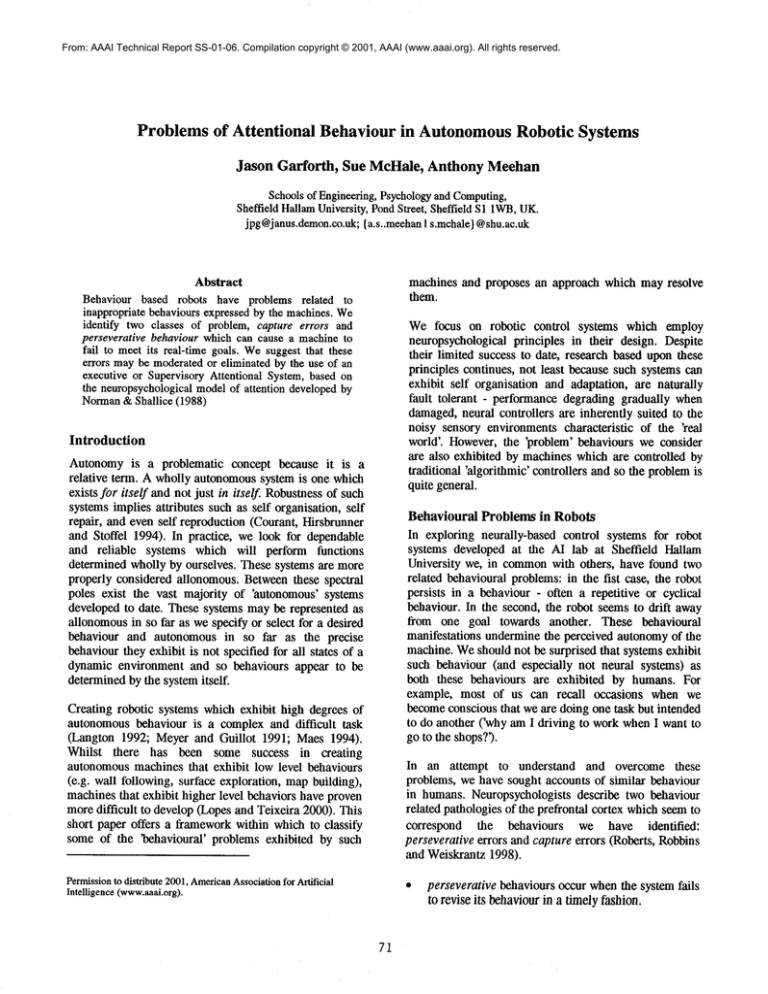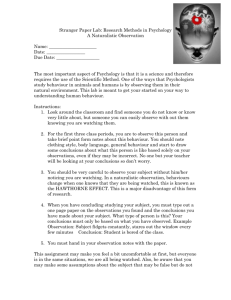
From: AAAI Technical Report SS-01-06. Compilation copyright © 2001, AAAI (www.aaai.org). All rights reserved.
Problems of Attentional
Behaviour in Autonomous Robotic Systems
Jason Garforth, Sue McHale, Anthony Meehan
Schoolsof Engineering,Psychologyand Computing,
Sheffield HallamUniversity, PondStreet, Sheffield SI lWB,UK.
jpg@janus.demon.co.uk;
{a.s..meehanI s.mchale}@shu.ac.uk
Abstract
Behaviour based robots have problems related to
inappropriate behavioursexpressed by the machines.We
identify two classes of problem, capture errors and
perseverative behaviour which can cause a machineto
fail to meet its real-time goals. Wesuggest that these
errors maybe moderatedor eliminated by the use of an
executive or SupervisoryAttentional System, based on
the neuropsychologicalmodelof attention developedby
Norman&Shallice (1988)
machines and proposes an approach which may resolve
them.
Wefocus on robotic control systems which employ
neuropsychological principles in their design. Despite
their limited success to date, research based upon these
principles continues, not least because such systems can
exhibit self organisation and adaptation, are naturally
fault tolerant - performance degrading gradually when
damaged,neural controllers are inherently suited to the
noisy sensory environments characteristic of the ’real
world’. However, the ’problem’ behaviours we consider
are also exhibited by machines which are controlled by
traditional ’algorithmic’ controllers and so the problemis
quite general.
Introduction
Autonomy is a problematic concept because it is a
relative term. A wholly autonomoussystem is one which
exists for itself and not just in itself. Robustnessof such
systems implies attributes such as self organisation, self
repair, and even self reproduction (Courant, Hirsbrunner
and Stoffel 1994). In practice, we look for dependable
and reliable systems which will perform functions
determined wholly by ourselves. These systems are more
properly considered allonomous. Betweenthese spectral
poles exist the vast majority of ’autonomous’ systems
developed to date. These systems may be represented as
aUonomous
in so far as we specify or select for a desired
behaviour and autonomous in so far as the precise
behaviourthey exhibit is not specified for all states of a
dynamic environment and so behaviours appear to be
determinedby the system itself.
Behavioural Problems in Robots
In exploring neurally-based control systems for robot
systems developed at the AI lab at Sheffield Hallam
University we, in commonwith others, have found two
related behavioural problems: in the fist case, the robot
persists in a behaviour - often a repetitive or cyclical
behaviour. In the second, the robot seems to drift away
from one goal towards another. These behavioural
manifestations underminethe perceived autonomyof the
machine. Weshould not be surprised that systems exhibit
such behaviour (and especially not neural systems)
both these behaviours are exhibited by humans. For
example, most of us can recall occasions when we
becomeconscious that we are doing one task but intended
to do another (’why amI driving to work when I want to
go to the shops?’).
Creating robotic systems which exhibit high degrees of
autonomous behaviour is a complex and difficult task
(Langton 1992; Meyer and Guillot 1991; Maes 1994).
Whilst there has been some success in creating
autonomousmachines that exhibit low level behaviours
(e.g. wall following, surface exploration, mapbuilding),
machinesthat exhibit higher level behaviors have proven
more difficult to develop (Lopes and Teixeira 2000). This
short paper offers a frameworkwithin which to classify
some of the ’behavioural’ problems exhibited by such
In an attempt to understand and overcome these
problems, we have sought accounts of similar behaviour
in humans. Neuropsychologists describe two behaviour
related pathologies of the prefrontal cortex whichseem to
correspond the behaviours we have identified:
perseverative errors and capture errors (Roberts, Robbins
and Weiskrantz 1998).
Permissionto distribute 2001, AmericanAssociation for Artificial
Intelligence (www.aaai.org).
¯
71
perseverative behaviours occur whenthe system fails
to revise its belaaviourin a timely fashion.
¯
Wesuggest that system control architectures which
explicitly address attention are necessary to build robust
systems that do not exhibit these problems(at least not to
a to a problematic degree). Wehave chosen to explore
this proposal by experimenting
with a control
architecture based upon the Normanand Shallice model
of willed behaviour (Figure 1) and as further elaborated
in (Shallice and Burgess 1998).
capture errors involve an inappropriate
or
undesirable switch to a different behaviouror goal.
These behaviours are associated with damage or
abnormalityin an area of the prefrontal cortex that seems
to initiate plans and modulates higher level behaviour:
functionally, it is referred to as the executive. The
concept of an executive as a part of the brain is currently
the subject of debate amongst both neurophysiologists
and neuropsychologists and several models exist notably
those of Struss and Benson(see Parkin 1996), Baddeley
(Baddeley and Weiskrantz 1993) and Norman and
Shallice (Shallice 1988). In the Struss and Bensonmodel
the executive is composedof processes which affect two
functional systems: drive and sequencing which in turn
control and influence other systems within the brain.
Both the Baddeley and Norman and Shallice models
contain an executive called the Supervisory System or
Supervisory Attentional System (SAS), respectively.
This model
components:
is composed of several
Perception Based Triggers: a (database) mapping
betweensensory input patterns, the internal state of
the agent including any goals that the agent
currently has (cognitive subsystems) and behaviours
(schemas).
Supervisory
Attentional
System
Perceptual
System
functional
Contention
Scheduler
Trigger
’Database’
Behavlours
(Schemas)
Cognitive SubSystems
Action
Figure 1. Anadaptation of Norman& Shallice’s modelfor willed and automatic control of behaviour which indicates
wherehumanscan interact with a (robotic) agent. The Trigger Databasemapsthe perceived state of the world and of the
system to a set of candidate behaviours. The ContentionScheduler deals with habitual (unconcious)behaviours that need
no attentional control. The Supervisor), Attentional Systemexerts "conscious" control to suppress unwantedbehaviours
such as capture errors or to ’force’ the expressionof a willed, possibly novel, behaviour(see Styles 1997).
72
failure of the SASto recognise the timely need for a
changeof goal or sub-goal.
A Contention Scheduling mechanism which is
invoked when selected behaviours are incompatible:
different behaviours are compared and adjusted
dependanton the situation the agent finds itself in.
(Comment:It seems to us that the modelof the basal
ganglia offered by (Prescott, Redgrave and Gurney
1999) relates directly to the function of the
contention scheduler.)
Implementation
Using the Norman and Shallice model as a neural
architecture requires a neural realisation of the functional
components (although it is not necessary realise all
componentsin this way to evaluate our proposals about
the SAS).
If an agent encounters danger, requires a novel goal
or recognises the selection of an inappropriate
action, the agent must actively suppress one
behaviour and exhibit another. This willed behaviour
is achieved by the intervention of the Supervisory
Attentional System (SAS).
The perception-based triggers for behaviour can be
realised as an associative memorybetween sensors and a
set of basis behaviours(Mataric 1996).
A ’winner-takes-all’ modelof the basal-ganglia (Prescott,
Redgrave and Gurney 1999) forms the contention
scheduler with the output for the effectors taken directly
fromit.
The role of the SASis distinct from a lower level action
selection mechanism such as may exist in the basal
ganglia. It provides an additional ’input’ to the system
which expresses a dynamic, ’willed’ component which
then influences action selection.
Wehave yet to determine the most appropriate neural
architecture for the SAS. Currently, we propose to
implement some of the hypothesised sub-systems,
particularly those componentsassociated with intention
markers (Shallice and Burgess 1998).
In humans the Norman & Shallice
Supervisory
Attentional Systemoperates in five situations:
¯
Situations that involve planning or decision making.
¯
Situations that involve correcting
shooting’ behaviours.
¯
Situations where the responses are not well learned
or contain novel sequences of actions
¯
Situations judged to be dangerous to the agent or
technically difficult.
¯
Situations that require the overcomingof a strong
habitual response or the resisting of temptation.
An Experimental Context
To explore this and other proposals we have chosen a
multi robot system for the behaviours relating sheep,
sheepdogs and humans in a working environment. The
problem of herding is one in which a robot is naturally
faced with a choice between contradictory goals and
behaviours. Sheepdogsexhibit herding behaviour and, in
interacting with people, they obey just four basic working
commands(Jones and Collins, 1987). The human input
is mainly designed to allow us to control one channel of
influence over the robots attention.
or ’trouble
The robotic sheepdogsare receptive to sound, so that the
human handler can control the machine in much the
same way as they would a real sheepdog. The main goal
is to try to influence the robotic sheepdogsattention so as
to produce behavioural changes. Oncethis is a repeatable
experiment, the SAS will either be suppressed or
damaged and the experiment repeated to ascertain
whether or not the attention of the robotic sheepdog is
altered in a predictable way, consistent with reappearance
of perseverative behaviours and capture errors, thereby
validating the model. It should be possible to distinguish
the functioning of the SASfrom that of the contention
scheduler (basal ganglia). Damageto the basal ganglia
real animals can lead to ’behavioural traps’ where
appropriate but alternating, ill-coordinated behaviours
are expressed. In contrast, a damaged SASin humans
can lead to inappropriate, but coordinated behaviours and
very frequent capture errors.
Thoughthe SASis now thought of as being a collection
of at least three subsystemsit is still classed as being a
single functional systemwithin the brain.
Direct evidence for the SASis severely limited, but
within neurophysiology the evidence for the existence of
an executive such as the SASor at least something that
can modulate attention, is mounting. Studies of several
specific brain diseases, notably Alzheimer’s, Parkinson’s
and schizophrenia (Cohen, Braver and O’Reilly 1998),
support the idea of an executive and/or supervisory
attentional control.
Capture errors can be explained using Norman and
Shallice’s model as a temporary failure of the SASto
recognise a change in unconscious goal oriented
behaviour. Perseverative behaviour is explained as a
73
Progress
To support the research we have built a hardware and
software laboratory, that includes:
An experimental robot ’SheepOne’ was built using
several 8 bit micro-controllers
and programmed
using a custom written ’C’ compiler. It exhibited
basic behaviours. Whilst it successfully managedto
wander around a room it exhibited
severe
perseverative errors for a given ultrasonic sensor
configuration. The behavioural errors shownby the
machine were identified as due to a lack of neural
memory of recent history. This was overcome in
simulation using Elman neural networks instead of
feed forward multi layer perceptrons.
The ’SheepTwo’robots: three wheeled robots, each
having four processors. The design includes a servo
based sensor head with low power CMOScameras,
two to three ultrasonic senor pairs and close-contact
switches. Using ultrasonic range finders and contact
switches the sheep can movefairly quickly around an
environment. Their controllers run on version of
Linux for embeddedmicro-controllers (uCLinux on
an RT-Control uCsimm system on a stick).
The
sheep form Sheffield HallamUniversity’ s flock being
built for research into emergent group behaviours
and as a focus of attention for the sheepdogs. Two
prototypes are currently operational. They exhibit a
range of basis behaviours such as avoid, roam,
approach, follow, aggregate (Mataric 1996).
Sheepdogs: six wheeled robots substantially larger
and more powerful. These machines use a flexible
communicationsarchitecture to connect processors
together. The superstructure is constructed from a
3U19" sub-rack frame mountedon top of the chassis
containing the drive mechanism and batteries.
Capable of supporting several on-board processing
units and large amounts of I/O these machines will
have a simple vision system as well as more
conventional sensors. As in the Sheep the Sheepdogs
machines use embedded Linux (uCLinux) as the
operating system, enabling rapid application
development and deployment. Twochoices for the
CPU’s are being evaluated: an RT-Control provided
uCdimm(available Q1 2001) and an AXIS Etrax
development board.
An evolvable neural architecture used to build the
controllers.
SheepWorld:a Java-based simulation for the sheep
and sheepdogsbuilt to validate the neural controllers
prior to porting to the physical machines.
Summary
This research project is focused on one of the problems
facing the builders of behaviour based autonomous
robotic agents namelythe occurrence of what we classify
as Perseverative behaviours invoked through an habitual
response which at some point in time become
inappropriate and Capture errors where an inappropriate
behaviouris not actively suppressedby the agent.
Wesuggested that the robustness of autonomousrobots
can be improved by implementing a neuropsychological
model of attentional control (Supervisory Attentional
System).
References
Beer, R., Chiel, H. and Sterling, L. 1990 A biological
perspective on autonomous agent design. Robotics and
AutonomousSystems Vol 6, 169-186
Baddeley, A., Weiskrantz, L. 1993. Attention: Selection,
Awareness, &Control. Oxford University Press. 152-170.
Cohen, J.D., Braver, T.S. and O’Reilly, R.C. 1998. A
computational approach to prefrontal cortex, cognitive
control and schizophrenia: recent developments and
current challenges in Roberts, A. C., Robbins T. W.,
Weiskrantz, L. (eds.) The Prefrontal Cortex. Oxford
University Press. 195-220.
Courant, M., Hirsbrunner, B. and Stoffel, K. 1994.
Managing entities
for Autonomous Behaviour in
Thalmann,N. and Thalmann,D. (eds) Artificial Life and
Virtual Reality. Wiley. 83-95
Jones G. H. and Collins B. C. 1987. A Wayof Life:
Sheepdog Training Handling and Trialling. Farming
Press.
Langton, C.G. 1992 Introduction. In Langton, C.G. et al
(eds.) Artificial Life II: proceedingsof the Workshopon
Artificial Life (February, 1990) Santa Fe, NewMexico,
Addison-Wesley.
Lopes, L.S. and Teixeira, A. 2000. Teaching behavioaral
and task knowledgeto robots through spoken dialogue.
AAAI Spring Symposium 2000, Stanford University, Ca.
USA.
Maes P. 1994. Modeling Adaptive AutonomousAgents.
Artificial Life 1: 135-162.
Mataric, M.J. 1996. Designing and Understanding
Adaptive Group Behaviour. Adaptive Behaviour 4:1 5180.
Meyer, J. A. and Guillot, A. (1991) Simulation
adaptive behaviour in animats: review and prospects. In
Meyer, J. A. & Wilson, S.W. (eds.) From animals to
animats, Proceedings of the First International
Conference on the Simulation of Adaptive Behaviour.
Cambridge, MA:MITPress/Bradford Books.
Parkin A. J. 1996. Explorations
Neuropsychology. Psychology Press.
in Cognitive
Prescott, T.J., Redgrave, P and Gurney, K. 1999. Layered
control architectures in robots and vertebrates. Adaptive
Behaviour 7(1) 99-127. International
Society for
Adaptive Behaviour.
Shallice, T. FromNeuropsychologyto Mental Structure.
CambridgeUniversity Press, 1988, Ch. 14.
Shallice, T. and Burgess, P. (1998) "rhe domain
supervisory processes and temporal organisation of
behaviour’ in Roberts, A. C., Robbins T. W., Weiskrantz,
L. (eds.) The Prefrontal Cortex. OxfordUniversity Press.
22-35.
Styles, E.A. (1997) The Psychology of Attention.
Psychology Press 1997, Ch 9.
75







